Air Quality
DPC has identified key parameters of concern in terms of air quality and developed monitoring programmes at 22 locations within Dublin Port as illustrated in the map below. The key parameters monitored and associated air emission limits that DPC targets for compliance are provided in Table 1.
Table 1: Air Quality Parameters
| Parameter | Target/ Limit | Target/ Limit Description |
| NO2 | 40 ug/m³ | Annual limit for protection of human health – Annual |
| SO2 |
20 ug/m³ |
Annual & winter limit for the protection of ecosystems – Annual |
| Benzene | 5 ug/m³ | Annual limit for protection of human health – Annual |
An effective dust monitoring programme has been agreed with Dublin City Council and is operational. Two permanent dust measuring stations have been established near sensitive receptors. Four additional dust monitoring stations were established in August and September 2019 in relation to licensed works and their locations agreed with the EPA.
Energy
Innovative energy solutions benefit the overall efficiency within the Port whilst also introducing benefits associated with time management aspects when collaborating with supply chains and climate change impacts. Reduced energy consumption and energy from renewable or circular means is indirectly linked with decreased greenhouse gas emissions and therefore human health. Dublin Port monitors its energy consumption across a number of different categories including, thermal energy, marine fuel and electricity.
Dublin Port Company implements an energy management programme that has so far seen the company exceed its obligations under the Public Sector energy efficiency targets. The energy management programme has been in place for over a decade since Dublin Port Company joined the Sustainable Energy Authority of Ireland (SEAI) partnership programme to support energy management initiatives throughout the Port.
The chart below shows the energy consumption in kWh between 2018 and 2022. Overall consumption continues to fall. As might be expected for a Port, Marine Oil is the largest portion of consumption, accounting for 51% of overall consumption in 2022. Note that marine oil consumption has fallen by 31% since 2018.
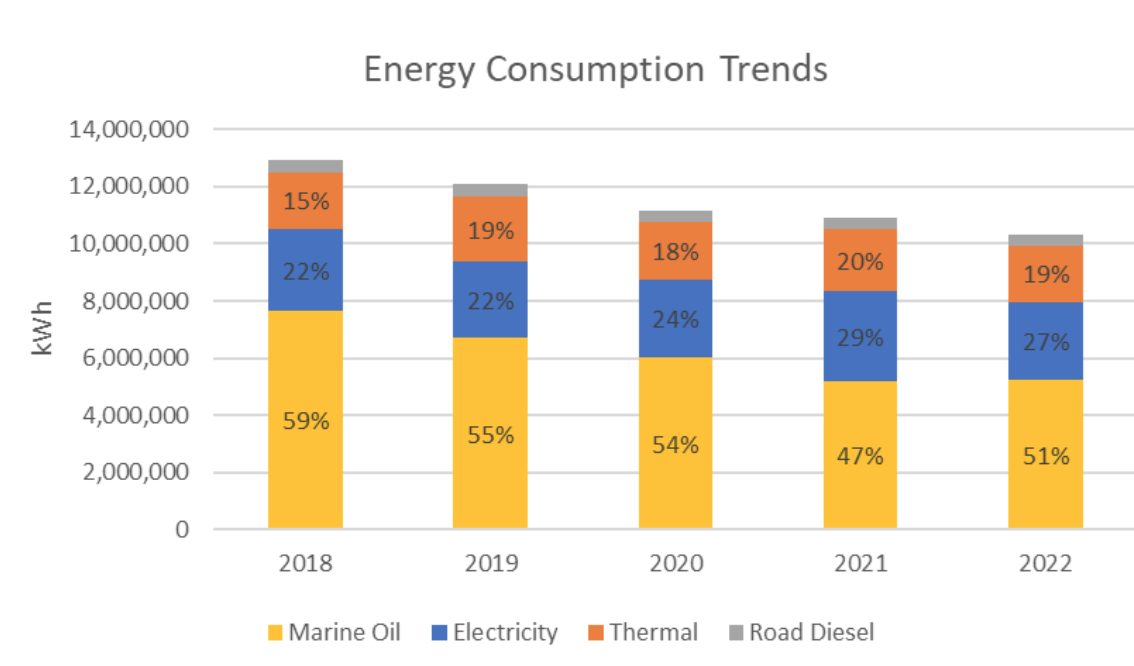
Noise
Permanent noise monitoring stations, as presented in Figure 3.13, have been established in the vicinity of a number of representative sensitive receptors to provide continuous measurements of noise levels and to determine if the Port activities, particularly construction, are resulting in noise levels of a magnitude that cause a nuisance. Three permanent noise monitoring stations have been established at Poolbeg Marina (Marina, Site D1), Dublin Port Centre (P&O, Site D2) and Clontarf (Clontarf, Site D3). These stations represent noise levels at the nearest sensitive receptors i.e., Pigeon House Road, the Gibson Hotel and Clontarf respectively. Dublin City Council have set noise threshold limit values for these locations.
Monitoring is carried out to identify any breaches of these limits and to allow effective mitigation measures to be implemented to reduce noise levels if Dublin Port activities are found to be responsible. At any time during monitoring when the noise limit levels are exceeded, the noise monitoring equipment records a sound file. This allows soundtracks to be listened to when reviewing noise data so that the source of the noise can be identified.
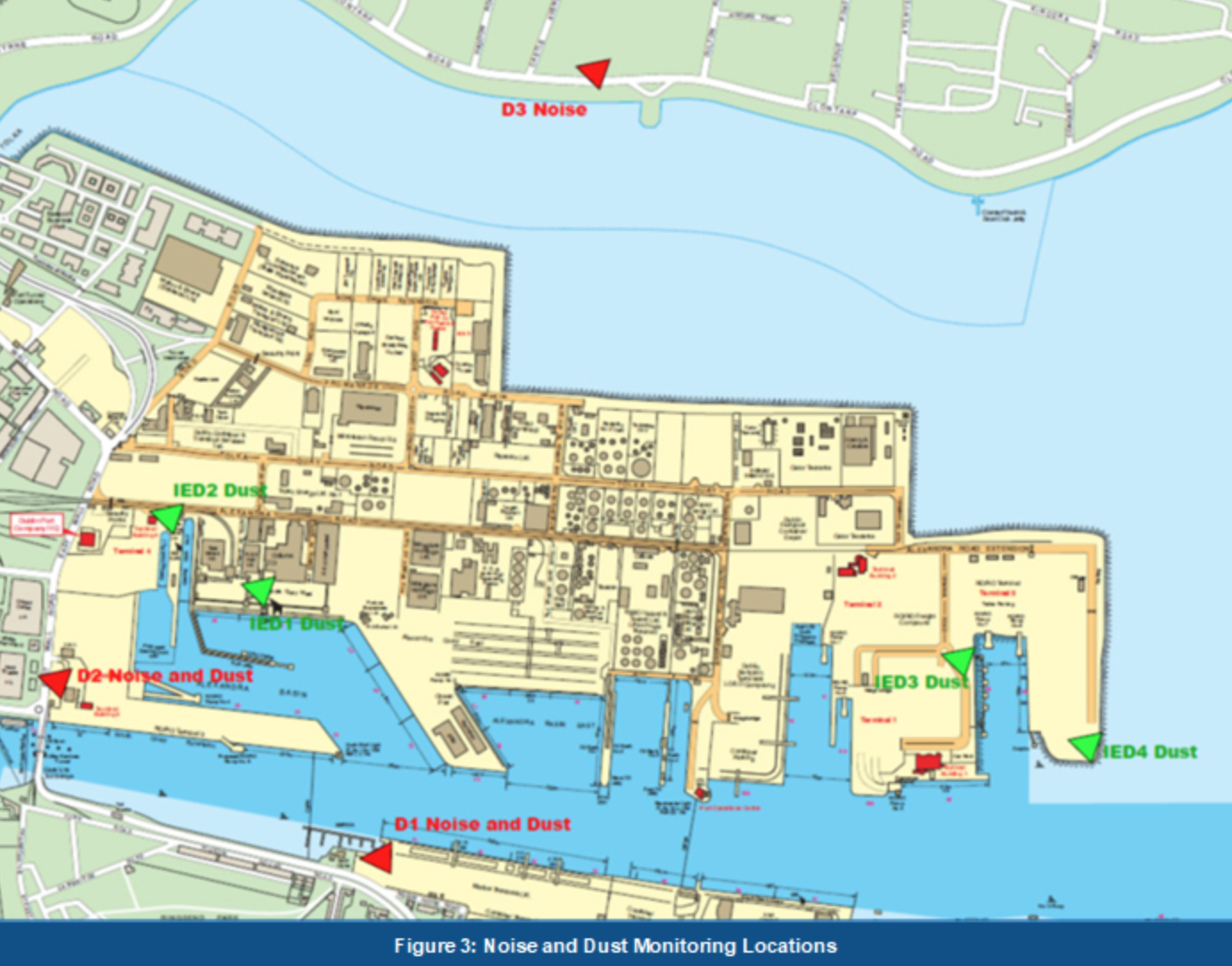
Monitoring has confirmed the general effectiveness of noise mitigation measures being implemented in line with best practice and the Noise Management Plan that has been put in place for ongoing construction projects.
Biodiversity and Conservation – Birds
Because Dublin Bay is among the top- ten most important wetlands in Ireland for migratory wintering waterbirds, DPC is supporting BirdWatch Ireland (BWI) in the continued programme for the monitoring and research of the waterbirds within Dublin Bay, the Dublin Bay Birds Project. DPC has committed to a further five years of support for the project. The surveys undertaken under this project recorded the distribution, abundance, behaviour and substrate being used by each individual throughout 23 subsites across Dublin Bay.
Colour-ringing, radio- and satellite-tracking allows fine-focused observations of individual birds, which will be used to support conclusions drawn from observations of larger flocks. These colour-ringed and tagged birds facilitate assessments of the importance of particular areas within the bay for feeding and for roosting, the possible variation throughout the season, the extent of movement throughout the winter (within Dublin Bay and between other east coast estuaries), the amount of population turnover within and across different areas and the likely differences in areas used during the day and at night.
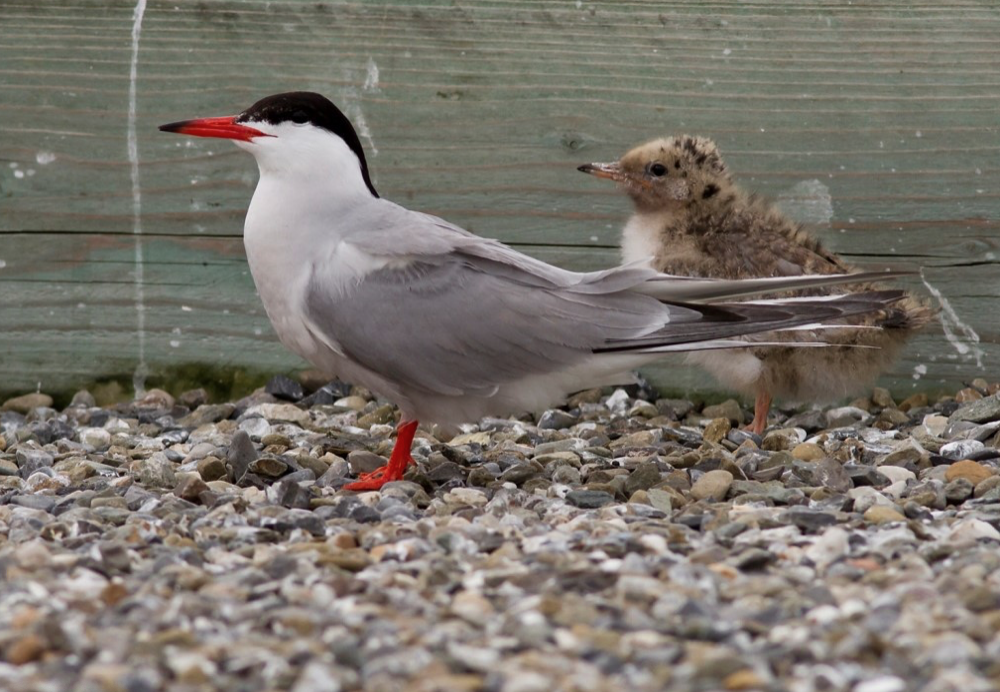
The results of the monthly bird counts during the most recent Winter Wetland Bird Monitoring Programme indicate that most numerous species were Pale-bellied Brent Goose, Oystercatcher, Dunlin, Redshank, Knot, Bar-tailed Godwit, Golden Plover, Black-headed Gull, Common Gull and Herring Gull.
A comparison of peak numbers and a mean of peaks for the last five winters reveals that the total number of birds in 2021/22, at over 20,000, was higher than average and the second highest total recorded over the last five years.
The monitoring that is undertaken under the above initiatives allows an evidence base to be established to determine any potential impact of Dublin Port activities associated with the expansion of the Port.
Examples of measures that Dublin Port has undertaken to ensure the protection of these important species and to allow the Port activities to continue without adverse impact on the bird populations include:
- Comprehensive monitoring programmes including the Dublin Bay Birds Project;
- Preparation of Black Guillemots Conservation Plan 2021- 2025, which proposes a range of measures including the addition of custom made nest boxes in strategic areas of the Port in a series of phases. 16 nest boxes have already been installed on the Oil Jetties in 2016 and several of these have since been used for nesting by Black Guillemots. Further nest boxes are proposed as part of the Black Guillemots Conservation Plan;
- Capital dredging works, undertaken as part of the development of the Port, are confined to the winter months (October–March), when Common Terns and Arctic Terns are absent from Ireland. This avoids any indirect impacts of the proposed development on these species.
- Suspension of activities during period of extreme low tide to avoid disturbance of foraging birds. This relates to both construction and operational activities, e.g., gates installed on the proposed Greenway will be closed during period of greatest low spring tides to avoid disturbance at feeding grounds within the Tolka Estuary.
Biodiversity and Conservation – Marine Mammels
Marine mammals share the waters of Dublin Bay with Dublin Port and there are a number of conservation designations, including the Dublin Bay Biosphere, where marine mammals are important features. These sites must be managed in accordance with the ecological requirements of the species and therefore it is important that the activities of Dublin Port do not negatively impact their ecology. Marine mammals are protected under national and international law. Thus, it is essential to have a good understanding and give full consideration to the long-term implications for marine mammals of the underwater noise activities associated with the activities of Dublin Port Company.
Marine Mammal Monitoring
To prevent potential impacts from DPC activities a Marine Mammal Mitigation Plan (MMMP) was prepared as part of the ABR Project to meet compliance with planning permission and licensing obligations. A range of monitoring programmes are being undertaken as part of the expansion of Dublin Port to ensure appropriate protection to marine mammals and to broaden scientific knowledge in relation the ecology of Dublin Bay.
Acoustic Monitoring
In line with best international practice, a combination of visual and acoustic monitoring techniques are being used to assess and mitigate against significant impacts on marine mammals, including harbour porpoise, grey seal and harbour seal. Static Acoustic Monitoring (SAM) is being implemented through the deployment of C-PODs and F-PODs.
SAM detects cetacean vocalisations and logs their occurrence. SAM is effective in assessing habitat use by cetaceans and is particularly useful in studying behaviours such as feeding strategies.
This monitoring provides information on the use of the sediment disposal grounds by harbour porpoise prior to, during and after dredging campaigns and establishes if any displacement from the site occurs.
The equipment is recovered and analysed every three months and the data is presented as detection positive minutes to generate an acoustic index of activity at the sites. This enables changes in activity to be identified at high resolutions for seasonal, diel (day/night) and tidal periods. Detailed analysis of the data provides opportunities for adaptive project management through regular feedback to environmental managers and contractors.
Dublin Port has also installed a PAM system at the approaches to Dublin Port to provide information on the presence of marine mammals during periods when visual mitigation is constrained. These techniques are to complement and not replace visual techniques. The LIDO (Listening to the Deep Ocean Environment) system was installed during the summer of 2022 as part of an international project undertaking long-term monitoring of marine ambient noise as well as marine mammal sounds. The use of PAM techniques can provide the scientific community with real-time data at large spatial and temporal scales.
Seal Survey at North Bull Island
Since May 2016, monthly seal surveys for grey and harbour seals have been carried out at North Bull Island. These monthly surveys have been carried out before, and during construction activities associated with Port expansion, and will continue for a minimum of two years post construction in line with international best practice. Since May 2016 the monitoring results show a clear pattern of grey seals present at North Bull Island from late April/May until October, when they seek more remote undisturbed sites such as Lambay Island to breed and moult. Harbour seals are present all year around on the island, with lower numbers present during the breeding and moulting periods (June – August).
Water Environment
Monitoring stations have been established in the Port to provide detailed information on relevant water quality parameters. They measure real-time water quality and continuously relay the data to a shore-based location for compliance assessment. Trigger levels that initiate investigations have been set for key water quality indicators to allow a quick response and remedial actions, including the temporary cessation of the works where appropriate.
Monitoring stations have also been established in Dublin Bay where the dredged material from Dublin Port is disposed to provide for the protection of the marine environment by way of monitoring of the impacts associated with the loading and dumping of dredged sediment from the Port at sea. Continuous real-time turbidity monitoring is conducted at four stations and at various depths, along with tidal current and wave climate analysis.
The information from the network of monitoring stations is supplemented by data collected by boat surveys in the estuary and Dublin Bay. Water samples are taken at fixed locations and along set paths that are strategically located to measure any impacts on water quality in the area, including behaviour and dispersal of sediment plumes.
The graphs below show the average daily values for turbidity, salinity, dissolved oxygen and temperature at each of the monitoring stations. Monitoring in the Inner Liffey Estuary has shown that turbidity levels have been very low over the entire period of record, 90% of all turbidity measurements being 10 NTU or less. Turbidity tends to be somewhat higher over the winter months because of the increased frequency of winter storms. Dissolved oxygenis consistently near saturation levels, showing a slight sag in summer months when water temperatures increase. Both turbidity and dissolved oxygen measurements indicate good water quality and no significant impact due to Port activities.
Monitoring in Dublin Bay has also confirmed that water clarity as measured by turbidity levels has been good. Monitoring took place at the dredge spoil disposal site at Burford Bank and at a site remote from the spoil grounds to compare background conditions. In the most recent annual period of monitoring, average turbidity was low and ranged from 7.2 NTU to 10.3 NTU over all four sites. 90 percent of all results were less than 20 NTU. ABR construction and dredging campaigns operated during the reporting period. Water clarity has been similar at the remote background site and at the dredged sediment disposal site, and monitoring indicates that the disposal of dredged sediment is not having an impact on water quality at the dump site or in the wider bay. Peaks in turbidity may be observed outside of dredging and dumping intervals, and also at the control site. Data has shown that water clarity is strongly influenced by tidal and storm events.
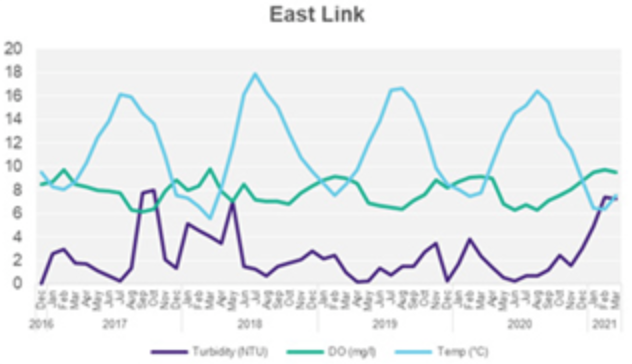
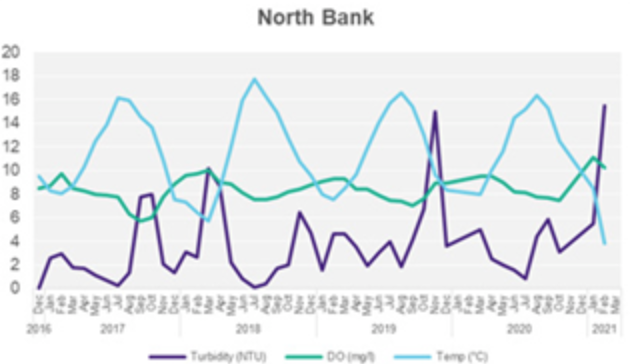
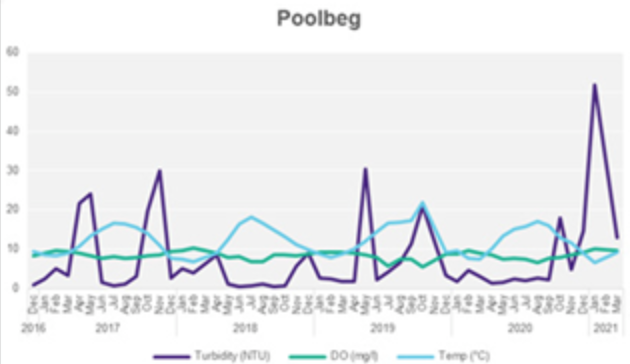
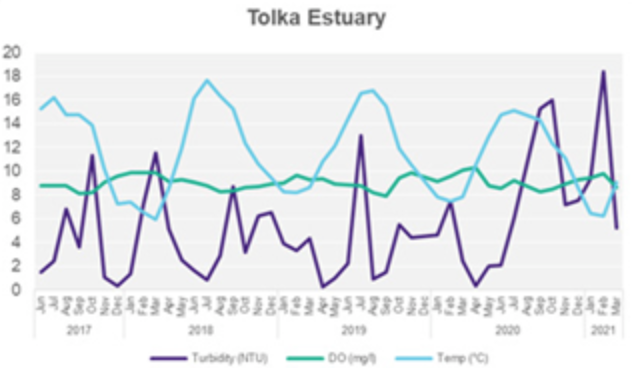
Waste
The EU Waste Framework Directive 2018/851 sets the legal framework for treating and managing waste and introduces a system of waste management called the “waste hierarchy”. The emphasis is on preventing,
reusing and minimising waste to the greatest degree possible. The actions, from highest to lowest preference, are prevention of waste from being created, minimisation, reuse, recycling, energy recovery and finally, disposal to landfill. The final objective is making the circular economy a reality, in other words, reusing a majority of waste material.
Ship Waste
Dublin Port Authority has appointed authorised officers who will conduct random compliance checks against the regulations on ships calling at Dublin Port. Particular attention is given over to checking compliance against Safeseas Ireland MARPOL – Landing Notifications and cross checking these against the Advanced Waste Notifications received to ensure the that ship waste is being managed correctly.
Port Waste
DPC has an auditing procedure to evaluates its compliance with environmental, health and safety (EHS) legislation and regulations identified in the company’s Legislation Register and with other requirements DPC subscribes to. Waste Management is a key area for audit compliance and in particular the levels of recycling that the company achieves. Dublin Port has consistently achieved a recycling rate of over 95% since 2013, with a peak of 98% in 2016.

